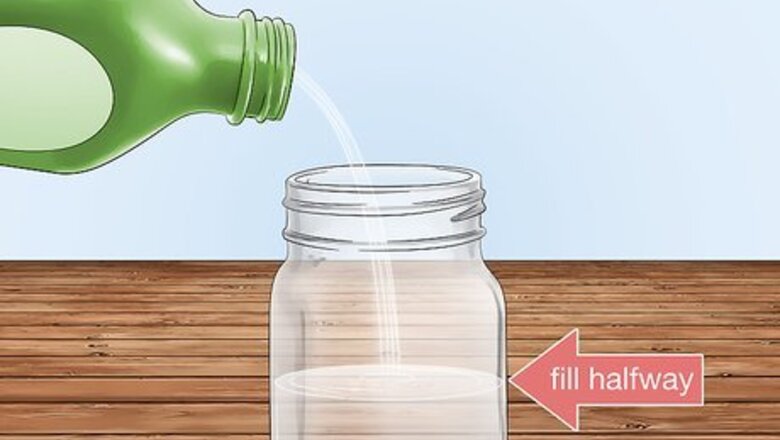
views
Preserving Insects in Rubbing Alcohol

Fill a small glass jar halfway full with rubbing alcohol. The rubbing alcohol will preserve the body of the insect and prevent it from decaying, drying out, or breaking into pieces. The jar should be larger than the insect, but not unnecessarily so. If you put a small insect in a large jar, you’ll waste rubbing alcohol. Most rubbing alcohol is a 70% solution—this should work well for preserving your insects. Stronger rubbing alcohol—at 80 or 85%--is also appropriate, as some insects are better preserved with a stronger alcohol. Examples of insects that should be preserved in stronger alcohol include: spiders, scorpions, earthworms, and small insects including lice and silverfish. Make sure that the glass jar has a tight-fitting lid and does not have any cracks.
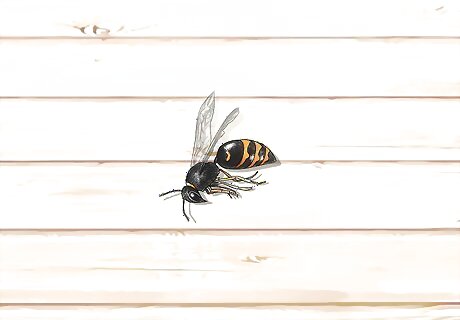
Find a dead insect. Keep in mind that soft-bodied insects are most commonly preserved in alcohol. The insect could come from anywhere: a window inside your house, the environment near where you live, or even from a nearby spider’s web. You’ll want to preserve an insect that is still in decent shape. If the insect has been dead for days and is already decaying and breaking apart, preserving it will be less effective. You can also trap insects yourself through a variety of methods: for example, catching moths and butterflies in a butterfly net. While some would object to the ethics of killing insects simply to preserve them, traps are an effective way to make sure you have dead insects available.
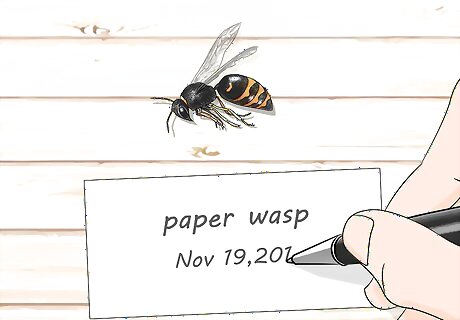
Identify and label your insect. When preserving insects, it’s important to know which specific species you are dealing with. This is an especially important part of the procedure if you are preserving insects for scientific purposes. The label should include: the genus and species of the insect, the date and location on which the insect was found, and the name of the collector. Tape the completed label to the outside of the alcohol-filled jar. There are many helpful websites that can help you identify the dead insect. Start by checking BugGuide.net or InsectIdentification.org. If these sites aren’t helpful, try to contact a local entomologist.
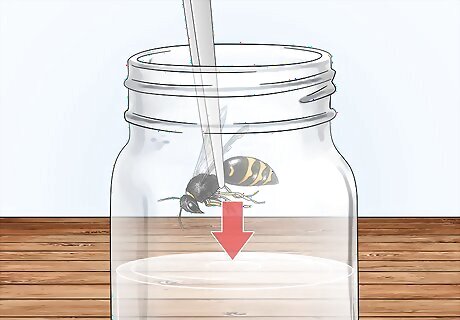
Carefully put the insect in the jar. Be delicate, and handle the insect carefully: its body will be very fragile and could easily be crushed. It’s best if you handle the insect with forceps or a pair of tweezers, as your fingers could break or damage part of the insect. If the insect has a stinger (bees, wasps) or is known to be poisonous, wear latex gloves when handling the body.
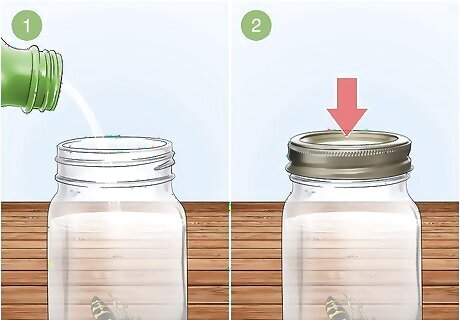
Fill the jar the rest of the way with rubbing alcohol. Only do this once the body of the insect has settled to the bottom of the jar. Pour the rest of the alcohol in slowly. If you pour too fast, the liquid may damage or break the insect’s body. Close and seal the jar, then store it in a safe location. If you’re planning on starting a large insect collection, it may be prudent to dedicate an entire tabletop to the jars. Store the insect jars far from food, children, and animals.
Preserving Insects in Hand Sanitizer
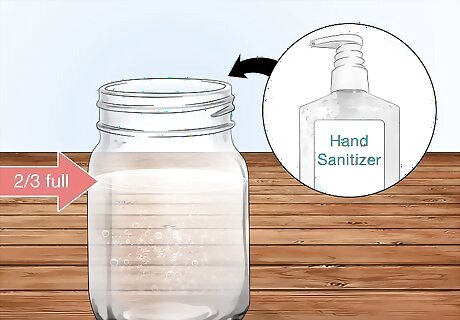
Fill a jar 2/3 full with hand sanitizer. Much like rubbing alcohol, the hand sanitizer will preserve the insect’s body and keep it from breaking or decaying. However, unlike alcohol, the thick consistency of hand sanitizer will suspend the dead insect, making for a more attractive display and facilitating easier viewing. Use a jar that is large enough to contain the suspended insect, but one that will not require a wasteful amount of hand sanitizer.
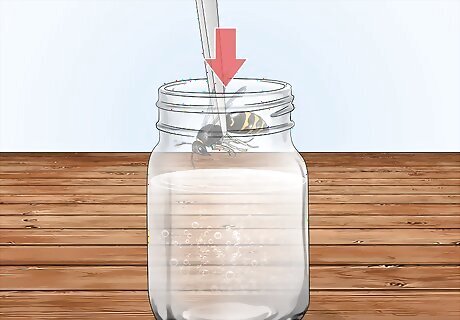
Place your dead insect in the hand sanitizer. Avoid handling the insect directly; use a pair of forceps or tweezers to pick the body up. Gently press the insect’s body down into the hand sanitizer, until it is suspended in the gel. If you’re suspending a delicate insect, such as a bee or wasp, take care not to break the wings or body when pressing it into the gel. Larger hard-bodied insects—such as butterflies—may be difficult to preserve in hand sanitizer, since the gel may snap off part of the body. While it’s OK to preserve other hard-bodied insects in hand sanitizer, look for ones that do not have delicate protruding wings or antennae.
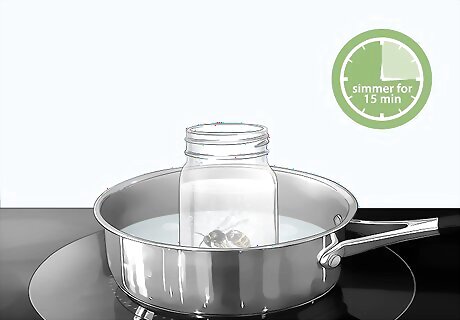
Boil the jars to remove air bubbles. To remove the unsightly air bubbles from the hand sanitizer, fill a sauce pan with 1–2 inches (2.5–5 centimeters) of water. Boil the water and place the jars (still 2/3 full of hand sanitizer, with the insect on top) into the boiling water and simmer for 15 minutes. Remember to leave the lid off of the jar, or it will explode. Avoid getting water into the jars, as it could weaken or dissolve the hand sanitizer. Many will consider the air bubbles aesthetically unpleasant and a distraction from observing the preserved insect. If you are not bothered by the air bubbles in the hand sanitizer, you can skip this step.
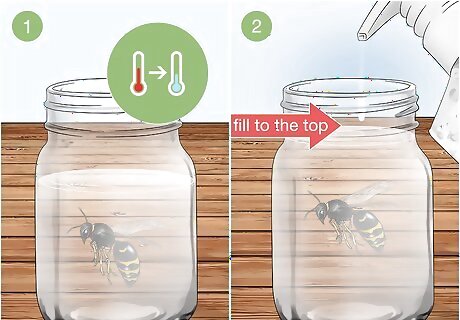
Fill the jar completely full with hand sanitizer. Once you have removed the jar from the boiling water and let it cool to room-temperature, pour or pump the hand sanitizer gel over the insect’s body until the jar is full. Once the jar is full, you can reach into the jar with tweezers or forceps to reposition the insect’s body until it’s displayed in the desired pose. Place a label on the outside of the jar, screw on the lid, and the preservation is complete. These jars can be handled by children (with adult supervision) and are excellent for museums or outreach events.
Pinning Insects
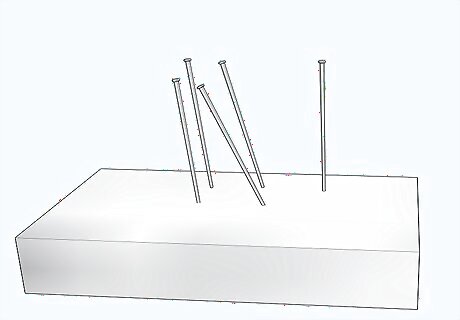
Purchase insect pins and mounting foam. Insect pins are a specific variety of push-pin, made of tempered steel and are typically 3.5 centimeters (1.4 inches) in length. They are quite thin, to avoid damaging the insect’s body. If you are pinning a thicker-bodied insect, use a thicker pin (vice versa for smaller or thinner insects). Any type of foam should work to mount insects, as long as the foam is dense (so that the pinned insect won’t fall over). It is also common to mount insects on cork instead of foam. Both insect pins and mounting foam (or cork) can be purchased at a hobby store or through a biological supply company such as BioQuip. Pins and mounting foam can also be purchased through online retailers, including Amazon.
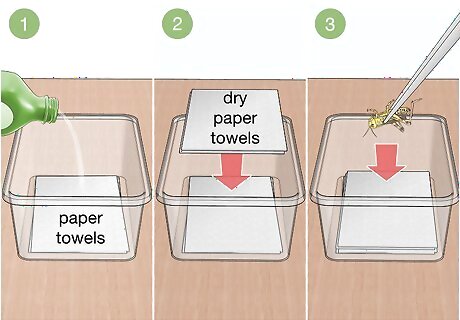
Rehydrate your specimen. If you plan on posing your insect, you will need to rehydrate it. If you can still move your insect's limbs with little to no resistance, you may skip this step. Find a sealable container. Dampen a rag or a few paper towels with rubbing alcohol and lay it on the bottom of the container. Ethanol, isopropyl alcohol, and even nail polish remover will work here. Do not lay your insect directly onto the wet towel. Place a folded piece of fabric or dry paper towels on top of the wet towel and place your insect on top of the dry surface. Your goal is to keep the insect dry while exposing it to the fumes from the alcohol. The key to doing this correctly is using lots of dry layers. Most hard-shelled insects take at least three days to rehydrate. Larger bugs need a minimum of five days to rehydrate. You may check on your insect every day, once you can move the limbs easily it is ready. If you add too much alcohol, use only paper towels, or leave the specimen to rehydrate too long, the specimen may get wet. This can cause the insect to deteriorate or rot. Avoid this by separating the insect from the wet towel with more dry layers. If your insect begins to deteriorate, you may be able to salvage it. Do not pick up the insect. Remove the dry surface it is lying on and set it out to dry, then try again once it is no longer wet.
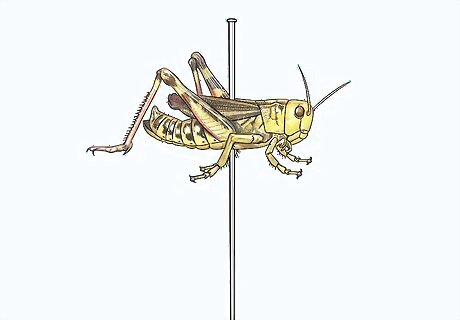
Impale the insect’s body on the pin. It is most effective to preserve hard-bodied insects by pinning. Stick the pin through the thorax (middle section) of your dead insect. Insert the pin until it is roughly 2/3 through the insect’s body; the idea is to be able to pick up and handle the pin without touching the insect. If you’re pinning a beetle, insert the pin through the middle of the right wing sheath.

Mount the insect and label on the foam. Press the pin down into the foam until it is about half an inch (1.3 centimeters) deep. Be careful not to disturb or break the insect’s body in this process. You may leave the specimen as you found it or use more pins to pose the body. If you are posing an older body, make sure it was rehydrated so you can move the limbs without breaking them. When posing the limbs, do not pin through the insect. Instead, place pins in the foam so the limbs lie against the pin. As the insect cures, the limbs will freeze in place. If you are struggling to keep the limbs from moving, you may place two pins in an X formation with the limb held in the top V of the pins like a hammock.
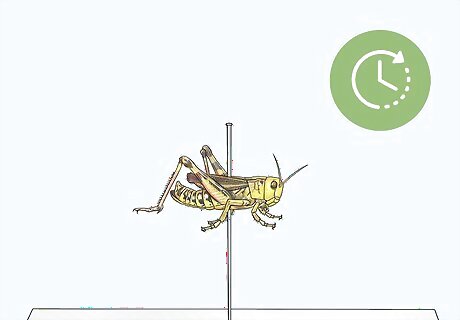
Leave the insect to dry. Depending on the size, this could take anywhere between one day to two weeks. Small insects like ladybugs will take about a day, bees take up to three days, and larger insects can take a week or more to dry. You can test if the insect is cured by gently pressing a limb with a pin. If the limb moves, it needs more time to dry, but if it is frozen in place, the insect is cured. Once your insect is cured, you may remove the posing pins and pin your finished insect in a shadowbox frame.

Create a label for the insect. Determine the insect’s genus and species, and print these clearly on a piece of paper. Also note the location and date on which the insect was found, and the individual who collected the specimen. Some collectors also note the environment from which the insect was collected: feeding on a leaf, found under a log, etc. Pin this slip of paper with the main pin in the body of the insect, or affix it nearby the specimen when you frame it. While the insect is not in a frame, protect your specimens by storing them in a cabinet or a set of drawers, or even by placing the pinned insects in a wooden cigar box. Adding mothballs to the box will protect from scavengers.
Pinning Butterflies
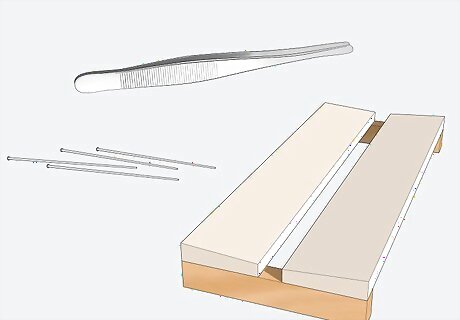
Purchase supplies. You will need insect pins and flat-tipped tweezers. Butterfly pins are thinner than insect pins. They range from .25 mm to .75 mm. If you are pinning a thicker-bodied insect, use a thicker pin (vice versa for smaller and thinner insects). They are typically 3.5 centimeters (1.4 inches) in length. DO NOT use regular tweezers. If they are not flat-tipped, they will rip the wings.

Prepare a spreading board. To make your own foam spreading board, take an even-surfaced piece of foam and cut a linear trough down the middle large enough to fit the full body of your butterfly or moth. Any type of foam should work to mount insects as long as the foam is dense (so that the pinned insect won’t fall over). Make sure your board is large enough for the butterfly or moth when its wings are outspread. It is also common to mount insects on cork or balsa wood instead of foam. You may make or buy spreading boards that have a V-shaped surface so your butterfly 's wings will be at an angle. It is best to buy these types of boards, but it is possible to make them. If you choose to make a wooden board this way, be careful that the wood glue will not get in the way of the fragile insect pins. Both insect pins and mounting foam (or cork) can be purchased at a hobby store or through a biological supply company, such as BioQuip. Pins and mounting foam can also be purchased through online retailers, including Amazon or The Butterfly Company.
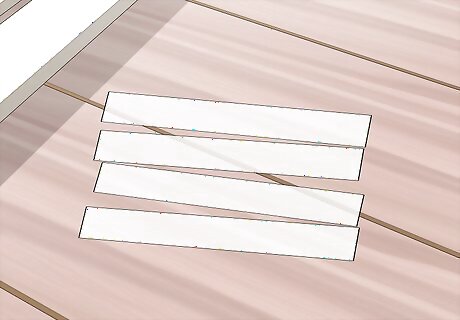
Prepare wax paper strips. Cut four wax strips the length of your butterfly's wings (from top to bottom) plus one inch. Since butterflies and moths are so fragile, it is easy to tear their wings. Because of this, the wings will be held in place by these wax paper strips so no pins can damage the wings. You may want to prepare some extra strips just in case.
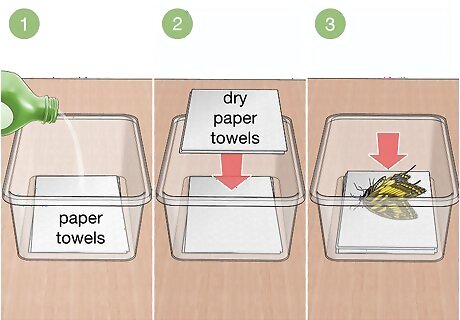
Rehydrate your specimen. Unless you have a freshly dead butterfly, you will need to rehydrate it. If you can still move your insect's limbs with little to no resistance, you may skip this step. Find a sealable container. Dampen a rag or a few paper towels with rubbing alcohol and lay it on the bottom of the container. Ethanol, isopropyl alcohol, and even nail polish remover will work here. Do not lay your insect directly onto the wet towel. Place a folded piece of fabric or dry paper towels on top of the wet towel, place a square of wax paper on that, then place your insect on top of the dry wax paper. Your goal is to keep the insect dry while exposing it to the fumes from the alcohol. The key to doing this correctly is using lots of dry layers. Small butterflies (1-5cm) can take as little as a day to rehydrate. Medium-sized butterflies (1-8 inches) can take a few days, and larger butterflies may take up to five days. You may check your butterfly by attempting to spread the wings. To do this, use tweezers to separate the two wings from the gap right above the head. If there is resistance, your specimen needs more time. If you begin the pinning process and the top wings are resistant and will not lay fully flat, it needs more time to rehydrate. If you add too much alcohol, use only paper towels, or leave the specimen to rehydrate too long, the specimen may get wet. This can cause the insect to deteriorate or rot. If this happens, it is likely the specimen will be too damaged to pin. Avoid this by separating the insect from the wet towel with more dry layers. If your insect begins to deteriorate, you may be able to salvage it. Do not pick up the insect. Remove the dry surface it is lying on and set it out to dry. Evaluate the butterfly. If the wings have stuck together, you may try to separate the wings with tweezers and place a wax paper strip between the wings until it dries. Try rehydrating again once it is completely dry.
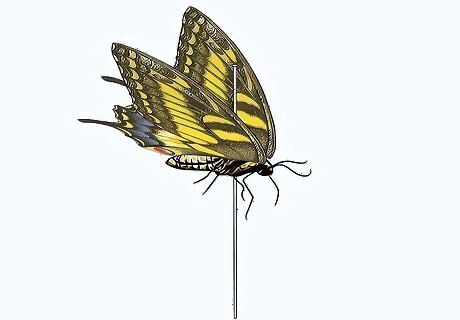
Impale the insect’s body on the pin. Once it is rehydrated, hold the butterfly by gently pinching the thorax. Holding it by the abdomen may cause it to break off. Your hand should be underneath and the butterfly's wings should be pointing upwards. Insert a pin in the middle of the thorax. This pin should be sticking straight up, not at an angle. Slide the butterfly down the pin until it is roughly 2/3 through the insect’s body; the idea is to be able to pick up and handle the pin without touching the insect. Pin the butterfly into the trough of your spreading board. It should sit deep enough that the bottom of the wings are parallel to the surface of the board. It is okay if your pin is at an angle as long as the wings will be able to lie flat.
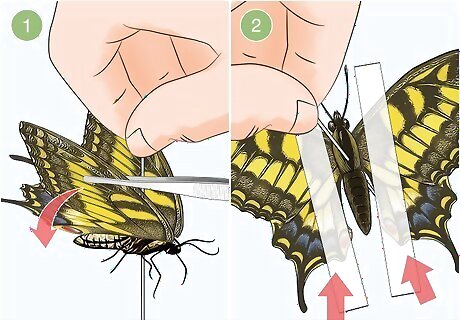
Separate the wings. Hold the wings open with your tweezers. While they are closed, slip them between the wings and let them open. Take a wax paper strip and slide it between the two wings. It should be long enough to stick out from both sides. Use this strip to pull the wings separate and place another strip on the other side of the pin. These will be used to hold the wings flat. If you can't separate them with tweezers, do not try to push the wax paper down through the top. This will most likely result in folding or tearing the wing tips. Try sliding the wax paper from the front (right above the head) as there is normally a gap between the wings at the shoulder joint.

Pin the wing down. Grab the wax paper and pull the wing down until it is flat on the spreading board. Do not place a pin through the wing, put pins through the wax paper. Make sure the paper is pulled tightly or the wings will not stay. Do this for both wings. If you begin the pinning process and the top wings do not lay fully flat, it needs more time to rehydrate. Do not press on them anyways, it will cause the wings to snap. You can leave the strips in between the wings while the butterfly continues to rehydrate for convenience. If the wings are slipping, pull the wax paper strips tighter and pin at an angle. Place the pins so that they lean away from the butterfly. This should keep the wax paper down more firmly.
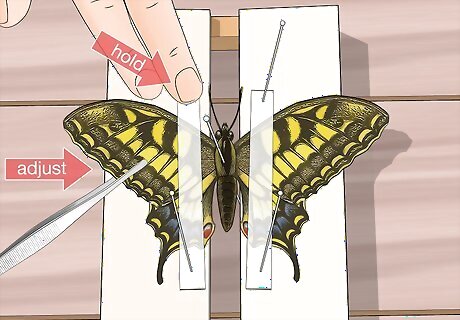
Position the wings and pin them into place. Start with the top wing. Temporarily unpin the top part of the wax paper strip. Do not remove the wax paper or the wing will close again. Do not touch the wing directly, instead hold the wing in place through the wax paper or with tweezers. Move the wing by releasing pressure and dragging it into place with your tweezers. Grab from the top of the wing, towards the middle. Do not grab it from the tip. When everything looks good, pin the wax paper down again. The bottom wings are more delicate. Grab from the side and drag up or down. Do not pull away from the body, the wing will tear. Pin it down. Remember to hold the wing you are not moving down while you position the other wing on the same side. Some butterflies have a thick vein towards the top of the wing. If you do not have flat-nosed tweezers, you may drag the wing with a pin with this vein. Do not point the pin downwards when you do this as you will likely puncture the wing. Hold it sideways and pin the wing in place with the paper as usual. Wearing gloves is advised, as the oils on the skin can remove scales. If your hands are sweaty, this may also pull scales off the wing, even through gloves and wax paper. Dry your hands frequently.
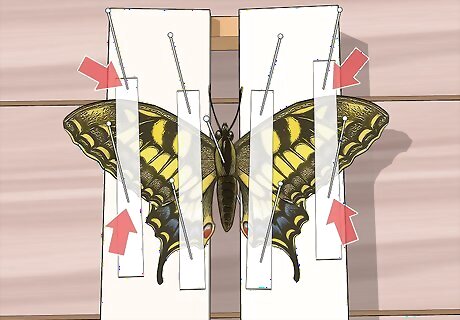
Finalize. If there are any areas that are not lying flat, cut some extra wax paper strips and pin the problem area down. If you somehow still have legs and antennae intact (they are super fragile), you can try and position them with extra pins. This step takes a lot of practice.
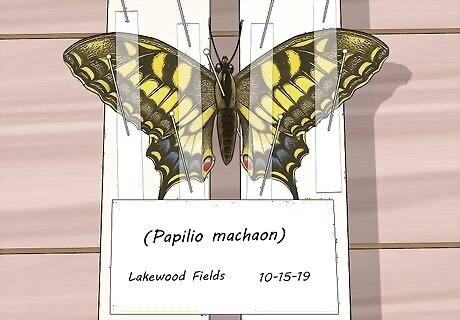
Create a label for the insect. Determine the insect’s genus and species, and print these clearly on a slip of paper. Also note the location and date on which the insect was found and the individual who collected the specimen. Some collectors also note the environment from which the insect was collected: feeding on a leaf, found under a log, etc. Pin this slip of paper with the main pin in the body of the insect. If you plan to develop a large collection of pinned insects, you may wish to start with a large piece of foam or cork, so the collection has room to expand. Protect the pinned insects by storing it in a cabinet or a set of drawers, or even by placing the pinned insects in a wooden cigar box. Adding mothballs from the box will protect from scavengers.














Comments
0 comment